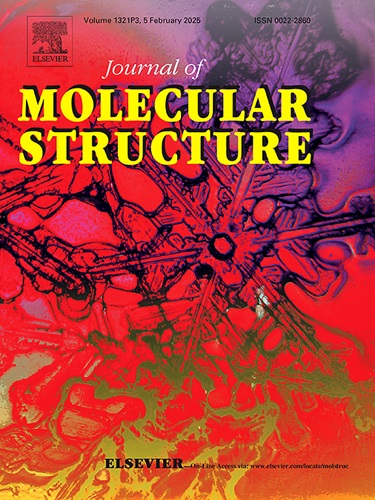Effective removal of Cr(VI) from aqueous solutions by covalent organic framework modified with the hyper-crosslinked aniline polymer: Adsorption performance and mechanism
IF 4
2区 化学
Q2 CHEMISTRY, PHYSICAL
引用次数: 0
Abstract
Due to their carcinogenicity and persistence, water pollution of heavy metals, particularly chromium (VI), presents a key environmental problem. The attractive properties of a covalent organic framework make it a promising adsorbent for removing pollutants from water. Nevertheless, the lack of diversity and number of functional groups and the insufficient stability of the covalent organic skeleton limit its potential for adsorptive removal of specific metal ions, such as hexavalent chromium Cr(VI). A series of COFs@HPAN composed of protonated hypercrosslinking aniline polymer (HPAN) and COFs were synthesized via Friedel-Crafts reaction of dimethoxymethane with aniline in the presence of COFs. The modification with COFs not only provides HPAN with a higher specific surface area and improves its dispersibility, but it can also result in COFs@HPAN surface rich in functional groups. The structure of COFs@HPAN is verified by different characterization methods, such as FTIR, XRD, SEM, BET, and so on. 1610 cm-1 (-NH2), 1657 cm-1 (C = N), 3388 cm-1 (N![]() H), and 2904 cm-1 (-CH2) confirms the successful introduction of HPAN at COFs@HPAN. The XRD pattern of COFs@HPAN shows excellent crystal structure with distinct characteristic peaks at 21.1o and 26.8°. The surface area, pore size, and pore volume of COFs@HPAN are 9.48 m2/g, 12.5 nm, and 0.04 cm3/g, respectively. SEM image shows COFs@HPAN contains numerous small pores, along with a high surface area and porosity, making it highly effective for Cr(VI) adsorption. The impact of time, initial pH, temperature, initial concentration, and ionic strength on Cr(VI) adsorption capacity was explored through batch tests. The adsorption is spontaneous and endothermic and follows Freundlich's isothermal adsorption and quasi-second-order model, suggesting chemisorption. At 318 K, the highest adsorption capacity of Cr(VI) was 412.26 mg/g. Additionally, COFs@HPAN has good anti-interference and reusability. Except for CO32-, SO42-, and PO43-, the presence of coexisting anions did not significantly affect Cr(VI) adsorption, and the adsorption capacity remained well above 166 mg/g after 10 cycles. Electrostatic adsorption, chelation, and reduction are the predominant processes regulating Cr(VI) removal. XPS analysis demonstrated a nearly 77 % reduction of Cr(VI) to Cr(III) through electron transfer from the electron-donating functional groups such as -NH2. The results show that COFs@HPAN have good Cr(VI) adsorption capacity and can be used for the treatment of Cr(VI) in acidic wastewater.
H), and 2904 cm-1 (-CH2) confirms the successful introduction of HPAN at COFs@HPAN. The XRD pattern of COFs@HPAN shows excellent crystal structure with distinct characteristic peaks at 21.1o and 26.8°. The surface area, pore size, and pore volume of COFs@HPAN are 9.48 m2/g, 12.5 nm, and 0.04 cm3/g, respectively. SEM image shows COFs@HPAN contains numerous small pores, along with a high surface area and porosity, making it highly effective for Cr(VI) adsorption. The impact of time, initial pH, temperature, initial concentration, and ionic strength on Cr(VI) adsorption capacity was explored through batch tests. The adsorption is spontaneous and endothermic and follows Freundlich's isothermal adsorption and quasi-second-order model, suggesting chemisorption. At 318 K, the highest adsorption capacity of Cr(VI) was 412.26 mg/g. Additionally, COFs@HPAN has good anti-interference and reusability. Except for CO32-, SO42-, and PO43-, the presence of coexisting anions did not significantly affect Cr(VI) adsorption, and the adsorption capacity remained well above 166 mg/g after 10 cycles. Electrostatic adsorption, chelation, and reduction are the predominant processes regulating Cr(VI) removal. XPS analysis demonstrated a nearly 77 % reduction of Cr(VI) to Cr(III) through electron transfer from the electron-donating functional groups such as -NH2. The results show that COFs@HPAN have good Cr(VI) adsorption capacity and can be used for the treatment of Cr(VI) in acidic wastewater.

超交联苯胺改性共价有机骨架对水溶液中Cr(VI)的有效去除:吸附性能及机理
重金属,特别是铬(VI),由于其致癌性和持久性,水污染是一个关键的环境问题。共价有机骨架的诱人性质使其成为去除水中污染物的有前途的吸附剂。然而,缺乏多样性和数量的官能团和共价有机骨架的稳定性不足限制了其吸附去除特定金属离子的潜力,如六价铬Cr(VI)。在COFs的存在下,二甲氧基甲烷与苯胺通过Friedel-Crafts反应合成了一系列由质子化超交联苯胺聚合物(HPAN)和COFs组成的COFs@HPAN。COFs改性不仅使HPAN具有更高的比表面积,提高了其分散性,而且还可以使COFs@HPAN表面富含官能团。通过FTIR、XRD、SEM、BET等不同的表征方法对COFs@HPAN的结构进行了验证。1610 cm-1 (-NH2), 1657 cm-1 (C = N), 3388 cm-1 (NH)和2904 cm-1 (-CH2)证实了HPAN在COFs@HPAN上的成功引入。COFs@HPAN的XRD谱图显示出优异的晶体结构,在21.10°和26.8°处有明显的特征峰。COFs@HPAN的比表面积为9.48 m2/g,孔径为12.5 nm,孔体积为0.04 cm3/g。SEM图像显示,COFs@HPAN含有大量的小孔隙,具有较高的比表面积和孔隙率,对Cr(VI)的吸附非常有效。通过批量试验探讨了时间、初始pH、温度、初始浓度和离子强度对Cr(VI)吸附能力的影响。吸附是自发的吸热吸附,符合Freundlich等温吸附和准二级吸附模型,表明是化学吸附。在318 K时,对Cr(VI)的最高吸附量为412.26 mg/g。此外,COFs@HPAN具有良好的抗干扰性和可重用性。除CO32-、SO42-和PO43-外,共存阴离子的存在对Cr(VI)的吸附无显著影响,循环10次后吸附量仍保持在166 mg/g以上。静电吸附、螯合和还原是调节Cr(VI)去除的主要过程。XPS分析表明,通过给电子官能团(如-NH2)的电子转移,Cr(VI)还原为Cr(III)近77%。结果表明,COFs@HPAN具有良好的Cr(VI)吸附能力,可用于处理酸性废水中的Cr(VI)。
本文章由计算机程序翻译,如有差异,请以英文原文为准。
求助全文
约1分钟内获得全文
求助全文
来源期刊

Journal of Molecular Structure
化学-物理化学
CiteScore
7.10
自引率
15.80%
发文量
2384
审稿时长
45 days
期刊介绍:
The Journal of Molecular Structure is dedicated to the publication of full-length articles and review papers, providing important new structural information on all types of chemical species including:
• Stable and unstable molecules in all types of environments (vapour, molecular beam, liquid, solution, liquid crystal, solid state, matrix-isolated, surface-absorbed etc.)
• Chemical intermediates
• Molecules in excited states
• Biological molecules
• Polymers.
The methods used may include any combination of spectroscopic and non-spectroscopic techniques, for example:
• Infrared spectroscopy (mid, far, near)
• Raman spectroscopy and non-linear Raman methods (CARS, etc.)
• Electronic absorption spectroscopy
• Optical rotatory dispersion and circular dichroism
• Fluorescence and phosphorescence techniques
• Electron spectroscopies (PES, XPS), EXAFS, etc.
• Microwave spectroscopy
• Electron diffraction
• NMR and ESR spectroscopies
• Mössbauer spectroscopy
• X-ray crystallography
• Charge Density Analyses
• Computational Studies (supplementing experimental methods)
We encourage publications combining theoretical and experimental approaches. The structural insights gained by the studies should be correlated with the properties, activity and/ or reactivity of the molecule under investigation and the relevance of this molecule and its implications should be discussed.
 求助内容:
求助内容: 应助结果提醒方式:
应助结果提醒方式:


